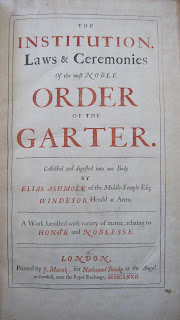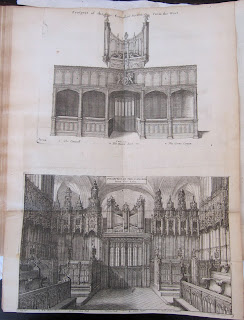 |
| title page |
 |
| Bookplate of Clements R. Markham, with notes |
Elias Ashmole, The Institution, laws & ceremonies of the most noble Order of the Garter. London, 1672
Renaissance Center copy is in modern half brown morocco and brown cloth; license-to-print and errata leaves wanting (supplied in facsimile); errata list also supplied in ms.; armorial bookplate of Clements R. Markham on front pastedown; mounted on front pastedown is a ms. note (perhaps extracted from a list of bequests?): "Fellowes. To Lilian Mrs. Fellowes daughter of my dear old messmate and friend Sir Vesey Hamilton. 1. Ashmoles Knights of the Garter [i.e. this work; followed by two other titles, both by W.H. St. John Hope]"; the note is likely by Markham, as both Hamilton and Markham served in HMS Assistance (DNB); laid in is a small sheet headed: "Some errors in the engraved coats-of-arms [at p. 708 ff.] noted by Reginald Courtenay in Feb. 1928.
Thus far I have used these blog entries to write about items absolutely unique to the Renaissance Center's collection, that is, books with manuscript material, identifiable provenance, or one-of-a-kind bindings. But today's entry centers on a printed book, one that is not unique to our collection, yet one that because of its remarkable qualities nevertheless deserves our attention. Its illustrations particularly deserve our attention (and reproduction through digital imagery), for they are some of the most beautiful plates ever produced by the etcher Winceslaus Hollar.
The book is Elias Ashmole's The Institution, laws & ceremonies of the most noble Order of the Garter, an impressive folio volume that describes its subject in over seven-hundred pages of carefully prepared antiquarian detail. Elias Ashmole was known variously as an astrologer, alchemist, and antiquarian, and in this latter capacity helped catalog the curiosity cabinet owned by the Tradescant family of Lambeth, a collection that would form the cornerstone of Oxford University's Ashmolean Museum. A staunch Royalist, Ashmole conceived of The Institution in the 1650s, a time when he feared that the long-standing and prestigious Order of the Garter (the founding of which is most commonly attributed to King Edward III) would slip into oblivion. The Order the Garter is Britain's most exclusive chivalric order, the members consisting solely of the monarch, Prince of Wales, and no more than twenty-four other noblemen. Ashmole intended his book as a "formulary" for the various practices and customs associated with the Order, and he hoped the extensive antiquarian and heraldic research he poured into the book would preserve those customs for posterity.
If the idea for the book began in the 1650s as a way to sustain Royalist and elite English culture in the absence of monarchical government, the book's post-Restoration publication in 1672 coincided with a reestablishment of the king's power and the Order itself, that "quintessentially Royalist cult" as Michael Hunt describes it (DNB). It may come as no surprise, then, that the book begins with a full-page engraving of Charles II (signed by William Sherman).
To round out the Institution's information about the Order's customs and ceremonies, the etcher Winceslaus Hollar was commissioned to create dozens of illustrative plates. These etchings are beautifully executed and amazingly detailed in their depiction of various buildings, material objects, and ceremonies related to the Order of the Garter. Even the book's historiated initials are beautifully illustrated, as seen in the images below (depicting St. George and the dragon, a symbol vital to the Order's iconography).
Hollar was well known for his etchings of buildings and churches, especially his ability to represent even the minutest of architectural details. The following images of St. George's Chapel at Windsor Castle—some of which appear in the book as folding plates—will give you a sense for Hollar's skill in this regard.
These images are also interesting because they depict a newly restored St. George's Chapel, a building which had suffered much damage at the hand of Parliamentary armies during the Civil War. While these images depict a empty space others outline the various processions and ceremonies the Order would perform within such spaces. The fourth image's depiction of wall tapestries in St. George's Hall is truly stunning in its detail.
 |
| detail of previous image |
Many of Hollar's plates illustrate the variety of material objects—most of them ornately decorated—that the Order of the Garter used in its elaborate ceremonies. The first image depicts objects worn by all Order members, such as the garter, collar, hood, surcoat, and feathered cap, as well as the "sovereign's mantle" worn only by the monarch.
This next image shows "the ancient habits and ensigns assigned to the Officers of the Order" juxtaposed against "the present habits, ensigns, and badges" of those same officers. The following images depict other badges worn by members of the Order.
Two other objects associated with the Order's ceremonies include the "bag of the seal of the Garter" and the "book of the seal of the Garter," both of which are shown below.
Finally, the book's plates also depict scenes related to European monarchs and their "investiture" into the Order of the Garter, as part of a chapter on "the investiture of strangers." The plate below shows "the manner of sitting at dinner" performed by Maximilian II (of the Holy Roman Empire) and King Ferdinand II of Spain during their feasts of investiture.
Probably my favorite image in the whole book also comes from this chapter. During the investiture of Charles XI of Sweden in 1668 (at Stockholm), his court put on an elaborate fireworks display to celebrate the conferment of this signal honor. Etchings of fireworks are simply beautiful, and this plate is no exception. There is something about the contrast between the light of fire and darkness of night that I find so striking in these images. As such, this delicate composition between light and dark is easily lost in poor photographic reproductions; the EEBO image of William Marshall's brilliant engraving of Egyptian fireworks in George Sandys' A Relation of Journey (1615) is a prime example. Here are Hollar's etchings of the Swedish fireworks:
 |
| detail |
 |
| detail |
To accompany the etching we have Ashmole's detailed description, which outlines the elaborate fire- and water-works shown in the image:
"The Fire-works above mentioned, which the King of Sweden caused to be prepared, to close the Solemnity of his Investiture, and manifest to the world his great satisfaction in the honor received, were ordered in the following manner. In the middle of the work was erected a great Pillar 52 foot high, on the top of which was placed a gilt Crown; 18 foot below the Crown were the initial Letters of the Soveraign's and King of Swedens Christian Names, set breast to breast: and below at the Foot were placed several Military Colours, both of Horse and Foot, filled with Fire-works. This Pillar stood in the middle of four antique Trophies, filled with Fire, and upon each side of the Pillar, 40 foot distance from it, was placed St. George on Horseback, having the Dragon under his Feet, of 24 foot in length, and 28 in heighth, and on each side of St. George two Pyramids of 36 foot high. In several places of the Work were set great Wind-Pipes, filled with Water, for playing of Water-Balls, and round the Work about 2000 Musket-Pipes, 60 together in a Frame, with 72 Chests in and about the Work, full of Rackets 12 foot high, besides 28 Chests with Swarmers in the Earth, 2 foot high; and above 1000 Pattroles fired by Degrees, which flying high threw from them all sorts of Figures of Fire. Lastly, at each corner a Fire Murser, which threw up all sorts of pleasant Fire-Balls, and in their breaking presented several figures" (423-4).
Hollar etched another image of fireworks based on a display he saw in Hemissem, Belgium, which you can see at the University of Toronto's spectacular digital collection of Hollar etchings.
I hope that the images I've provided above do justice to this beautiful book, yet I still encourage you to see it in person if you can, for it is truly a remarkable piece of craftsmanship, not only in its marshaling of a vast body of antiquarian knowledge, but also in its composition as a material book.





























No comments:
Post a Comment